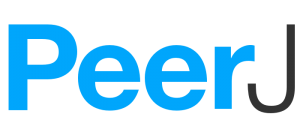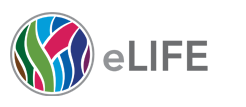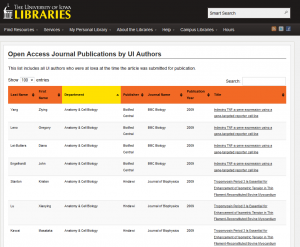Open Access Week 2014 begins today, and we’ll be running posts by guest bloggers on open access and contemporary scholarship. Today’s post comes from Bernd Fritzsch, Chair and Professor in the Department of Biology, and panelist in last month’s Open Access and the Public Good discussion.
The changing landscape of publishing: are we witnessing a revolution in information flow through open access?
Bernd Fritzsch
I am old enough to remember the ‘good old days’ when we went through the ‘Current Contents’ every week to find out what had been published journal by journal. Once you had identified a paper of interest, you needed to request a reprint, which you received maybe several weeks to several months later. You had to keep track of what reprints you requested, what you received and archive all of that in an ever increasing collection of reprints.
This started to change with the introduction of online journals—a new concept following the introduction of the world-wide web. Now, once you had identified a paper of interest you could possibly download a PDF of the entire article or at least see its abstract for a better assessment of fit for your interest. That was around 2000. In the last 14 years this concept of online, open access journals is increasingly pitched against the traditional journals. These novel ideas for access can potentially solve the biggest problem of the past—the unequal flow of scientific information—by providing easy access for everyone.
One major difference between open access and ‘traditional’ journals is the basic business model. Traditional journals rely, at least to some extent, on subscriptions to make a profit. How much a given journal profits from subscriptions is variable and the data is hard to come by. Given the high cost of subscriptions, budget-strapped libraries are faced with deciding which journal subscriptions are the most useful for their audience. The citation impact factor was developed by ISI initially to give libraries an idea of which journals are highly cited and read, helping them determine which journals they need to hold. Of course, once the idea of ‘impact factor’ was established for journals, the same system was used to rank authors. In essence, publishing in a prestigious journal with a high impact factor that is found in every library and many individual labs, was one way of making sure that a given scientific insight was widely disseminated. Journals, in turn, were interested in acquiring the highest impact factor to be widely subscribed. The problem with this business model is that the tax payer pays at least twice: first to finance the research that drives the lab of the author and subsequently to finance the library subscriptions. NIH has argued that this is an undue support and these arguments have changed the business model: now, papers, whose research was funded by NIH, have to be made available free to the public within one year. The authors, however, pay nothing in most cases, but have to sign over the copyright of data generated in most cases by public funding to a for profit organization. The problem with this model is that not every journal is easily accessible. In many cases one can only access abstracts unless a given University has a subscription that allows online access. Given that most researchers have their ‘reprint collections’ on their hard drive or the ‘cloud’ as PDF files, the possibility of accessing a given PDF instantly is becoming the rate limiting factor for information dissemination.
Since 2000 a different business of publishing is gaining ground: open access journals such as BMC journals, PloS journals and, more recently, eLife. These journals have no printed copies and thus no subscriptions by individuals or libraries to finance their costs. Upon acceptance of a paper, the author pays a fee to allow online access for all potential readers. The importance of this new business model is that data are immediately available for all to see and download as PDF to build up your own computer based library. Unfortunately, payments have to be made by the author, but the author typically retains the rights for his/her data. Of course, once the power of the internet become apparent to traditional publishers, most have added online access to their journals, in addition to the traditional paper journal (although this is sometimes at additional expenses to the author). Of course, impact factors of the new exclusive online journals are next to irrelevant for libraries (they do not need to subscribe to them) and are now only used to gauge the ability of a given set of authors to move a paper into a higher impact journal, allegedly being seen by more people, a questionable argument at a time of all access search engines.
Indeed, the very perception of a high impact journal carrying more weight because it is more being widely read is becoming debatable. At a time when several online journals provide statistics for each paper such as views per months, number of downloads of PDFs, number of citations including links to citations etc., other metrics that are easily accessible to evaluate ‘impact’ are moving into the forefront. Instead of ‘guessing’ the possible impact of a given article based on the ‘impact factor’ of a journal, one can now see the impact unfolding in real time for every article in these journals or for every author across journals. This allows every author to compare the impact development of their papers published in a low as compared to a high impact journal. In fact, only time can tell how a publication will fare: some papers will be cited frequently early and phase out, others will start with few citations and last. In addition, several online indices exist (Scopus, Google Scholar) that measure the real time impacts of any given paper from any journal. I recently looked at this data for papers I had published in the same year in high impact journals (Nature, for example) and low impact journals. I discovered that it did not matter where I had published my research: over a 25 year period the quality of the paper seems to equalize, at least for my sample, the impact factor difference of the journals; both papers were nearly equally cited. In my area of expertise, one of the most cited papers by T Dobzhansky (1708 times) is in a journal with an impact factor of around 0.4, highlighting my point namely that highly cited papers can appear in ‘low impact’ journals. Moreover, since the h-index was invented nearly 10 years ago, it is now possible to calculate for every author the total citation impact of her/his publication record as a measure of the life time impact. This measure is becoming more widely accepted. In many countries tenure and promotion decisions are partly based on not only the numbers of papers published and the impact factor of the journal, but increasingly the cumulative impact of a given faculty through the h-index.
Having a clearer understanding of what the changes in publication landscapes imply, one can begin to ask questions about the future success of the traditional versus the open access models, in particular in the context of faculty promotion. In my opinion, h-index is here to stay as a measure of overall citation frequency of papers of a given author. Modifications to correct for academic age, such as the m-index, combined with overall citation frequencies (provided by Google Scholar or Scopus) can provide a reasonable measure of how many people found the work of a given author useful for their own work and thus cite it. Variations of these measures can look into position of a given a faculty in the list of authors (middle name in a 20 people assembly of authors or first name in small set of authors). However, this will not change the basic usefulness of existing quantifications of a given author’s impact, they will only fine tune the results.
How will all of this affect frequency of reading of a given publication? Because it is now possible to search across all publications in seconds followed by the direct access not only of an abstract but the entire article information flow will speed up and help to develop a given idea. My expectation is that the traditional publication approach will disappear over time and most papers will go on line proportional to the phasing out of senior scientist used to the traditional model. My guess is that the revolution in disseminating information that started with typesetting by Gutenberg in 1450 (in China already around 1000) will soon be replaced by all electronic media. In addition, I expect that journal articles will transform into online fora of open discussions of the content of journals, not just consumption. ELife has already developed some of these novel publishing ideas such as the publication of the peer-review along with the article and the author’s rebuttal letter–things that are kept top secret by traditional journals. In addition, anybody can comment on the paper and such comments will become a permanent record. Combined, open access and open communication will help stamp out scientific fraud. The quality of the review process along with the publication of the name of the reviewer will ensure that anybody who cannot repeat the work can immediately interact with the authors via the online fora. This will change publication as we know it from a static process forming a one-way street of information flow (author to journal to library) into a dynamic process that will turn the scientific community into an intellectual village of worldwide openly communicating individuals. Clearly, ranking of universities such as QS University relies for 20% of the total ranking on citations per faculty, requiring that faculty should make sure that all their citations are properly credited to them. Easy ways to do this is through Google Scholar profile (or Scopus or Web of Science profiles).
I believe that the essential stumbling block for these new models of truly free communications, data, and idea exchange will be how to finance these forward looking endeavors that are transforming our publication landscape. Nearly 500 years after printing helped the public to gain access to scriptures, restricted before to the knowledgeable few, online open access publications could become the next step forward in free information flow, provided the financial models can be resolved. Other online features such as Facebook or Twitter will help to drive the free communication enterprise even further into accessibility by everyone.
Further reading:
http://www.nature.com/news/open-access-the-true-cost-of-science-publishing-1.12676
https://twitter.com/elife
http://theconversation.com/schekmans-luxury-journal-boycott-doesnt-go-far-enough-21145





